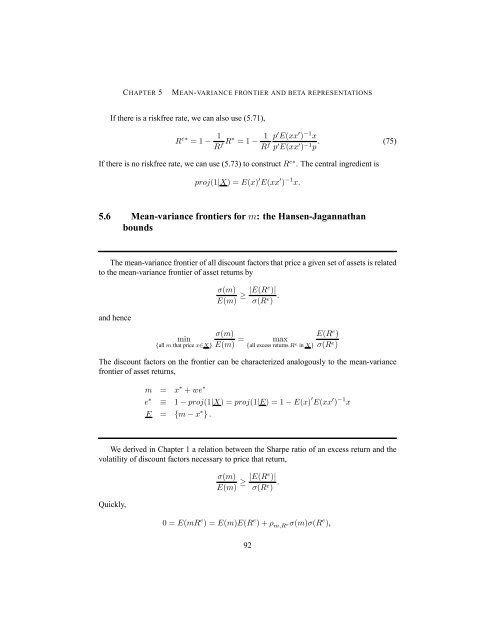Asset Pricing John H. Cochrane June 12, 2000
Asset Pricing John H. Cochrane June 12, 2000
Asset Pricing John H. Cochrane June 12, 2000
You also want an ePaper? Increase the reach of your titles
YUMPU automatically turns print PDFs into web optimized ePapers that Google loves.
CHAPTER 5 MEAN-VARIANCE FRONTIER AND BETA REPRESENTATIONS<br />
If there is a riskfree rate, we can also use (5.71),<br />
R e∗ =1− 1<br />
R f R∗ =1− 1<br />
R f<br />
p0E(xx0 ) −1x p0E(xx0 ) −1 . (75)<br />
p<br />
If there is no riskfree rate, we can use (5.73) to construct R e∗ . The central ingredient is<br />
proj(1|X) =E(x) 0 E(xx 0 ) −1 x.<br />
5.6 Mean-variance frontiers for m: the Hansen-Jagannathan<br />
bounds<br />
The mean-variance frontier of all discount factors that price a given set of assets is related<br />
to the mean-variance frontier of asset returns by<br />
and hence<br />
σ(m)<br />
E(m) ≥ |E(Re )|<br />
σ(Re ) .<br />
σ(m)<br />
min<br />
= max<br />
{all m that price x∈X} E(m) {all excess returns Re E(R<br />
in X}<br />
e )<br />
σ(Re )<br />
The discount factors on the frontier can be characterized analogously to the mean-variance<br />
frontier of asset returns,<br />
m = x ∗ + we ∗<br />
e ∗ ≡ 1 − proj(1|X) =proj(1|E) =1− E(x) 0 E(xx 0 ) −1 x<br />
E = {m − x ∗ } .<br />
We derived in Chapter 1 a relation between the Sharpe ratio of an excess return and the<br />
volatility of discount factors necessary to price that return,<br />
Quickly,<br />
σ(m)<br />
E(m) ≥ |E(Re )|<br />
σ(Re ) .<br />
0=E(mR e )=E(m)E(R e )+ρ m,R eσ(m)σ(R e ),<br />
92
















